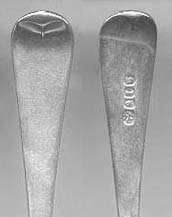|
|
The Collecting Place Settings Forum The forum's posts/subject/threads are closed.
This forum can only be viewed |
|
How to Post Photos
Want to be a Moderator?
|
|
|
The Collecting Place Settings Forum The forum's posts/subject/threads are closed.
This forum can only be viewed |
|
How to Post Photos
Want to be a Moderator?
|

|
 SMP Silver Salon Forums SMP Silver Salon Forums
  Collecting Place Settings Collecting Place Settings
  Georgian Old English Georgian Old English
|
| next newest topic | next oldest topic |
| Author | Topic: Georgian Old English |
|
Bob Schulhof Posts: 194 |
  
 Special Features 1. The "rib" becomes less prominent and what remains is just a vestigial "tip". This pattern is often called "Tipt" in the US. Dating As with all English silver, the pieces may be dated to within the nearest year by the Hallmarks. The seasons are sort of like the NBA, just one year long but running between two years- like 1798-99. There are any number of good books on the subject for example: The Book of Old Silver, English American, Foreign, by Seymour Wilder, Crown Publishers Inc. NY. This makes them highly collectible, as compared to American flatware which often cannot be dated to the nearest century. The pieces shown here date individually from 1798 (luncheon fork) to 1823 (teaspoon). The fork below shows a good example of a complete set of marks. The first thing to look for is the Lion Passant (on his nose in the picture) which is actually the second mark from the top. This tells us we have .925 Sterling. Next it would be important to determine the city symbol, which is the crowned Leopard's head indicating London. Without knowing the city, we could neither interpret the date nor the maker for there is a different series of these for each city. At the top is the makers marks which actually shows a WE over WF . Wilder attributes these marks to London Goldsmiths William Eley and William Fearn circa 1797. The letters A thru U were used to define the date within a twenty year span. The C shown here with the Kings head could be either 1798-99 (Geo III) or 1818-19 Geo IV. Pieces Available You will note there is no knife of the pattern. These would be supplied by separate cutlers until the late 19th century, usually of the pistol grip variety. Photo: Key Pieces Comments IP: Logged |
All times are ET | next newest topic | next oldest topic |
  |
|
Ultimate Bulletin Board 5.46a
|
copyright © 1993-2022
SM Publications
All Rights Reserved. Legal & Privacy Notices |